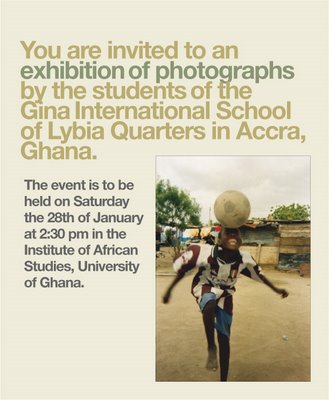
A lot has happened in the last few months. In January we held an exhibition of
the students’ work at the institute of African Studies in the University of Ghana. For those of you who weren't able to make it I'd like to share some of the highlights with you. The School for International training generously volunteered their classroom in the Institute of African Studies for us to use as the gallery space. Special thanks to Gavin Webb, Yaw Gyamfi, Kokroko Gyamfi, Clara Nsiah, Godwin Azameti, Anita Lynn Tawiah, David Chan, Georgina Dorkuvie, Agbekor Gidi, Collins Amlalo, Danny Abotei and Bob Heller who volunteered their time, energy, resources, wisdom, and magical powers to make the event possible. Since the classroom was occupied during the week leading up the event, we had about twenty-four hours to set up the exhibition. Many of those people I mentioned above spent the wee hours of the morning before the exhibition hanging black cloth from the walls and mounting 8x10 prints with selected short passages created by the students.
At one point late in that night, we went out to take a break and get a cold drink. When Yaw and I returned to the courtyard a half hour later, the gates to the Institute of African Studies had been locked, presumably by the late-night grounds crew. We scoured the entrances for an opening, but all gates were secured by pad-locks. At this time, with nearly half of the exhibition still unfinished, I began to breathe very heavily—mostly just inhaling. Yaw didn’t seem notice and disappeared into the darkness. Moments later he was calling me from inside the gates, dangling a loose padlock on his finger.
“I used some herbs from the bush,” he explained, grinning.
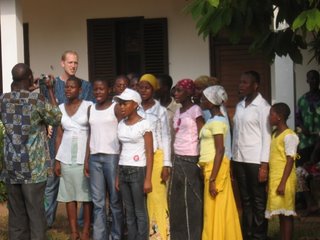
The event drew a diverse mix of people including the teachers at the Gina School, the students, their families and neighbors, members of the university community, photographers, ex-pats, pan-africanists, and a random assortment of folks who had just seen the posters plastered around town. After threatening rain for days, the overcast skies provided needed shade for the attendees mingling in the courtyard throughout the afternoon. The students’ sang their school anthem and their favorite pop song to kick off the program.
Coming off of two days straight with no sleep and having forgotten to eat that morning in the printer failure/ general mayhem leading up the event, I attempted to make a speech to the crowd and forgot most of the essential points I had spent month preparing. I must have reasoned that the best way to prepare myself for this nerve-racking moment was to simply not prepare myself at all. What I remember most is that, as I began to speak,
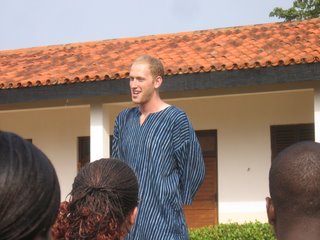
the equatorial sun came out and burned away the clouds. There I stood squinting, dazed, and wondering how to at least make myself short if not sweet. What I did remember to do was --and this was really the whole point of holding the event-- to thank the families for their patience and participation in this project over the year, as often they were subjects in their children’s pictures or were the photographers themselves. I thanked the Gina school and its faculty for making music, dance and drama a part of the curriculum and for embracing the idea of adding photography as an after-school program in the Junior Secondary. In my closing remarks I posed the question “Why are pictures important and why is it important that children take pictures?” Beads of sweat pouring down my face, I searched for an answer to this question.
Godwin Azameti,
 who has collaborated with me in teaching the kids and planning for the exhibition and who had been videotaping the event thus far, came to the rescue. Handing me the video camera, still running, he delivered one of his many eloquent speeches. This and other excerpts are taken directly from the video transcript.
who has collaborated with me in teaching the kids and planning for the exhibition and who had been videotaping the event thus far, came to the rescue. Handing me the video camera, still running, he delivered one of his many eloquent speeches. This and other excerpts are taken directly from the video transcript.“Photography, as a matter of fact, in our society is not respected. You see people hanging cameras from their necks and you don’t give them the respect. But as I am a photographer, Sam brought this idea that he wanted to teach children photography. Why this idea? Well, children see things in their own perspective and adults also see things in their own perspective. But children have some funny ways of coming by certain things. And when you look at it, you sit back and analyze it, you see a lot of wisdom in what children do...the photographs capture the photographers
themselves.”
I was pleased to hear Godwin talk about his passions as a film-maker and photographer in Ghana—using images to tell stories and preserve history and culture --and to acknowledge that the students have something important to offer their own community as well as the rest of the world. This is something he had shared with the students in class, but it seemed an especially important point to be raised at this event.
Next up on the program, I called Stella Apeke, the oldest girl in the class and one of the strongest student photographers, to deliver a short speech she had written. There was some murmuring in the crowd and Stella whispered nervously that she had forgotten it at home. Visibly disappointed, I said something to the crowd like, “Well, there’s no handing that one in late, so I guess you failed.”
I wrapped up the first phase of program and encouraged everyone to move their chairs to shady places. Being the baggy-eyed grump that I am, as the students gathered in the S.I.T. library to bring out the food, I scolded Stella in front of all her classmates for her carelessness. “I didn’t forget anything at home,” I told her.
The students then served food and drinks to the guests and the party began.
Agorsor, a neo-traditional dance band, provided live musical entertainment with a thrilling guest appearance by my housemate and master drummer, Francis Akotuah, which really got the party jumping. The students and guests danced, ate, and wandered in and out of the gallery space.


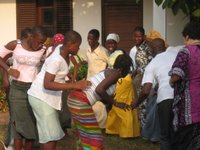
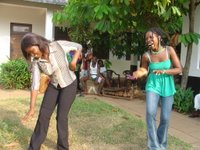
After a few hours, the chairs were re-assembled and the program resumed with a speech by the Georgina Dorkuvie, the founder and proprietor of the Gina school. She thanked me for what I was doing for the school and the students. She then thanked all the parents for coming and scolded those parents who had opted not to attend or had left early.
I asked if anyone else would like to say anything to the crowd. Stella Apeke stood up, walked to the front of the crowd and, without any notes, delivered her speech:
“Photographs are important. And photographs are important to me. When you are growing, you snap pictures of yourself to remember when you were small. Sometimes, I look at the time when we were babies there in the picture, and I just laugh because I’ve grown. Scientists, Engineers and doctors take pictures of the things they’ve made and show it to the world. Maybe you’ve not seen the president of the United States but because his photograph is all over the world, you can identify him. Thank you.”
The crowd cheered including a standing ovation from Stella's classmates. More speeches began pouring in. Eddie's grandmother came up and raised her favorite gospel song, Akpe Na Mawu, while the other Ewe people in the crowd sang along in their common language. Then Teacher Hayford performed a monologue in Shakespearian fashion, entitled “if I had a voice” about his hopes for the future of the nation:
“Oh, if I had a voice. If I had that loud and sounding voice to call on decision makers to make policies that will enhance the growth of our people. I wish I had a voice. That loud and sounding voice to tell parents to spend their last earnings towards the education of their young. Oh, I wish I had that voice again to tell my young people to arise and shine and build this nation. I wish I had that voice to call all the society to work toward the development of our people. Amen.”
One man, Berlinda's father I believe, came up and delivered a speech that included standing on a chair and later rolling on the ground, imitating a photographer in the act of finding the perfect angle for a shot. "As for photographs," he said, "I like
them too much."
The crowd roared with laughter and applause. Numerous other speakers, including University students and faculty who had just been passing by the courtyard, stood up and praised the students’ work. When it was getting dark, I decided it was time to close the ceremony. Seeing as most events in Ghana open and close with some kind of prayer and taking into consideration that there were many different religions in the school community, I decided to improvise a non-denominational prayer. Somewhere in the middle of my ramblings about the magical wonders of the trees and the dirt, I noticed my face was tingling and I was seeing little lights out of the corner of my vision. I decided to finish up – and everyone joined me on this one-- with a simple “amen.” The crowd slowly dispersed. The students stayed on later to clean the area, stack the chairs, take their pictures down from the wall, and return the coolers and catering supplies to campus canteen before finally asking permission to return home.
At this point my wonderful beautiful friend, Clara Nsiah, who had helped enormously in the planning of the event (no chairs or food without Clara), tapped me on the shoulder and handed me a plate of rice and chicken she had set aside for me earlier that day. “Go
sit down and eat this,” she said.



